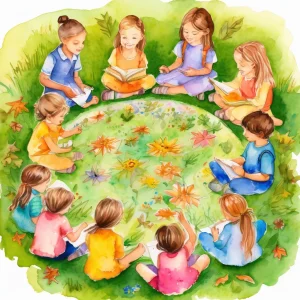Activity
Similar Activities
Enchanted Musical Story Time Adventure
Children’s Age: 2–2.5 years
Activity Duration: 5 – 15 minutes
Join our "Musical Story Time Adventure" for children aged 24 to 30 months! This interactive activity boosts cognitive skills, cultural awareness, and language abilities through spo…
Activity Duration: 5 – 15 minutes
Enchanted Nature Collage Walk Adventure
Children’s Age: 1.5–2 years
Activity Duration: 5 – 10 minutes
Explore nature and boost creativity with the "Nature Collage Walk" activity designed for children. This engaging activity encourages communication, language development, and a love…
Activity Duration: 5 – 10 minutes
Enchanted Tales: Family and Friends Story Theater
Children’s Age: 2–7 years
Activity Duration: 10 – 25 minutes
An interactive storytelling activity promoting language, academic, and social development.
Activity Duration: 10 – 25 minutes
Sensory Treasure Hunt: A Magical Exploration Journey
Children’s Age: 0 month – 6 years
Activity Duration: 10 minutes
Let's go on a Sensory Treasure Hunt! We will use our senses to explore different items like textures, scents, and sounds. You can feel, smell, and listen to each item while blindfo…
Activity Duration: 10 minutes
Engaging Holiday Memory Game for Kids
Children’s Age: 2–6 years
Activity Duration: 10 minutes
Let's play the Holiday Memory Game! You and your child can enjoy this fun activity together without needing any materials. Find a cozy spot, sit down, and get ready to play.
Sta…
Activity Duration: 10 minutes
Enchanted Digital Family Storytime Journey
Children’s Age: 6 months – 1.5 years
Activity Duration: 5 minutes
Engage your child with "Digital Family Storytime," a captivating activity tailored for children aged 6 to 18 months. Through interactive storytelling on a tablet or smartphone, thi…
Activity Duration: 5 minutes
Enchanted Coding Adventure Storytelling with Imagination
Children’s Age: 10–12 years
Activity Duration: 45 minutes
The "Coding Adventure Storytelling" activity is tailored for children aged 10-12 to enhance empathy, play skills, language abilities, and introduce basic programming concepts in a …
Activity Duration: 45 minutes
Enchanted Nature Walk: The Sensory Adventure
Children’s Age: 1–1.5 years
Activity Duration: 10 minutes
Engage your 12 to 18-month-old in the Sensory Nature Walk to boost their language, sensory, and social skills through outdoor exploration. Prepare for the adventure by dressing you…
Activity Duration: 10 minutes
Enchanted Digital Nature Scavenger Hunt: A Journey Through Technology and Nature
Children’s Age: 12–16 years
Activity Duration: 30 – 40 minutes
The Digital Nature Scavenger Hunt is a engaging activity tailored for children aged 12 to 16, promoting language development, communication skills, empathy, and computer literacy. …
Activity Duration: 30 – 40 minutes
Enchanted Reflections: Peek-a-Boo Mirror Play
Children’s Age: 6 months – 1 year
Activity Duration: 5 minutes
"Peek-a-Boo Mirror Play" is a wonderful activity designed for infants aged 6 to 12 months, focusing on language development and self-awareness. With a handheld mirror and a soft bl…
Activity Duration: 5 minutes
Seasonal Textures: Infant Sensory Exploration Activity
Children’s Age: 3 – 6 months
Activity Duration: 10 minutes
Engage infants aged 3 to 6 months in a sensory exploration activity focusing on seasonal textures for motor, adaptive, and language development. Gather soft fabric swatches, natura…
Activity Duration: 10 minutes
Imaginary Adventures: Mini Bowling Feelings Story Game
Children’s Age: 2–5 years
Activity Duration: 10 minutes
An engaging activity promoting sensory development, creativity, reading, and storytelling.
Activity Duration: 10 minutes


























